#ancient city of Tarquinia
Text

Ancient Roman Elite Necropolis Discovered in Italy
A two-year dig to install a solar power plant near Rome has unearthed an ancient Roman necropolis containing 67 skeletons buried in 57 ornate tombs.
Archaeologists were baffled by the find — thought to date between the second and fourth centuries — not least because the skeletons were discovered wearing golden jewelry and expensive leather footwear, inside tombs designed to resemble their homes.
The discovery, on a 52-acre patch of land close to the ancient city of Tarquinia, north of Rome, was a surprise to authorities, despite the area being renowned for such findings.
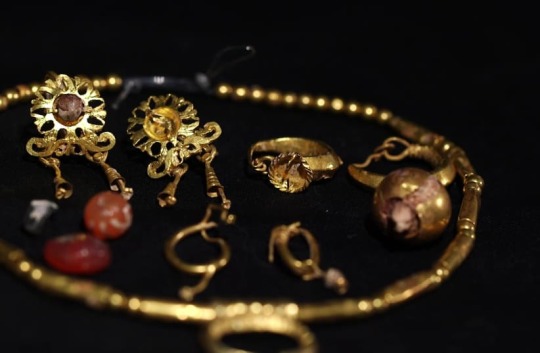
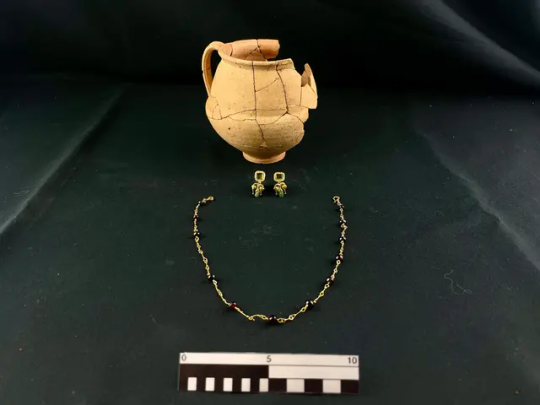
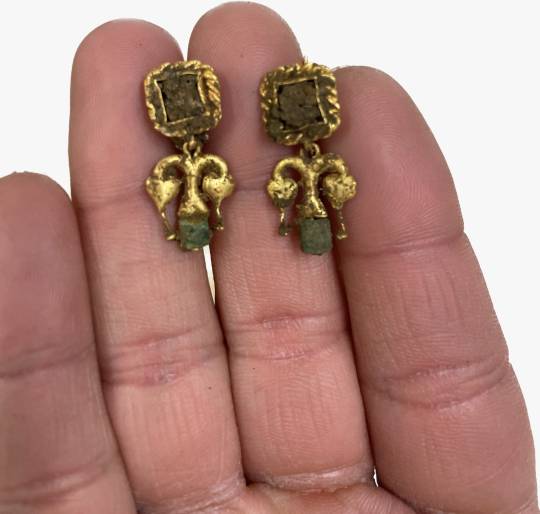
Silver rings with amber and engraved initials, precious stones, terracotta pottery, coins, shiny glasses, amulets and even items of clothing were found alongside the golden necklaces and earrings.
“We found several skeletons still wearing their expensive stockings and shoes,” Emanuele Giannini, lead excavation archaeologist at the site said. “All these riches, and the fact that the bones show no sign of stress or physical labor, (leads us to believe) these weren’t local farmers, but upper-crust members of Roman families coming from cities.”
Giannini said techniques of “pre-emptive archaeology” such as field surveys and trial trenches were used to identify potentially ancient constructions below ground.
“We did have a faint idea that some treasure could lie there, as historical sources mentioned the location of a postal station for travelers near the site,” explained Giannini. “Many Romans would stop (here) for the night to eat and rest, but the magnitude of the discovery is unmatched.”


The diversity of funerary objects laid near the remains, and the luxurious designs and linings inside the tombs, have led archaeologists to believe that the occupants wanted to recreate heavenly spaces similar to their earthly homes. The interior of many tombs originally featured elaborate cloth linings, or were surrounded and covered by tiles or terracotta pieces like little houses.
Giannini said another astounding aspect is that most of the discovered tombs were communal — built for at least two occupants who likely shared a family link. A few skeletons were found wrapped around each other.
“Building tombs for entire family nuclei is a typical ancient Roman trait,” he said, “but these are outstanding in their inner decor, which shows wealth and status.”
The shallow tombs were found just 20 inches below the surface — almost popping out of the grass — yet nobody had ever noticed anything peculiar.
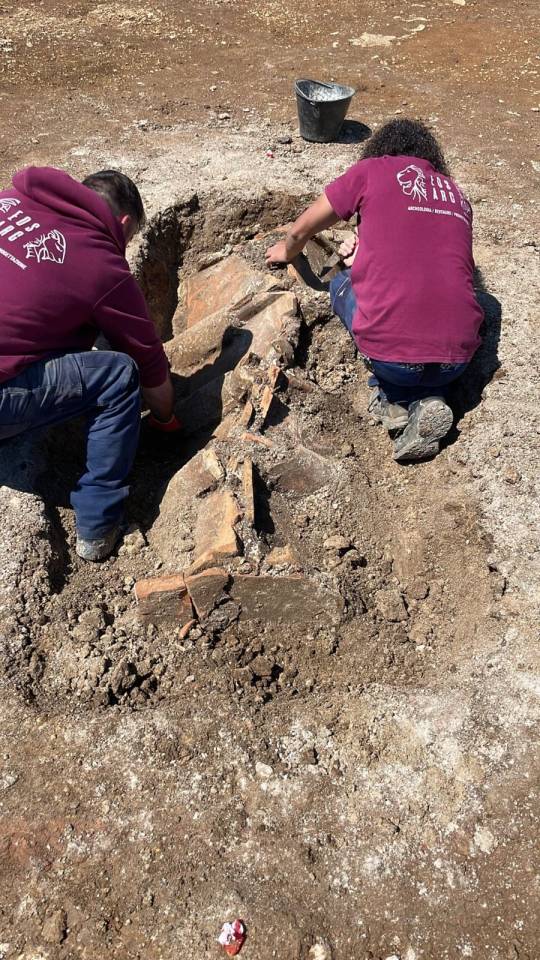



The site’s unique state of preservation has been attributed to the fact that “huge limestone blocks that stick out of the ground (made) ploughing, seeding and modern farming impossible in the area,” said Giannini. “It has remained untouched (for) centuries.”
Findings from the dig, which started in 2022, are being preserved as they’re found and many are going on show at the castle of Santa Severa in the coastal town of Santa Marinella. The skeletons however, are being analyzed to determine their origins and will not be put on display until forensic tests have been carried out.
Whatever their genesis, authorities are certain more hidden wonders will come to light as digs for the solar park move to another nearby site.
“We are excavating a huge rural area to redevelop the land and are balancing the need to avoid ruining such unique wonders with the goal of boosting clean energy production,” Margherita Eichberg, art heritage superintendent of the provinces of Viterbo and southern Etruria for Italy’s Culture Ministry said. The area where the necropolis has been discovered will not form part of the solar park and will be cordoned off for safety reasons, without public access.
“This is the fascination and beauty of Italy: Each time there’s a dig, incredible wonders from the past come out of the ground which need to be preserved.”
By Silvia Marchetti.

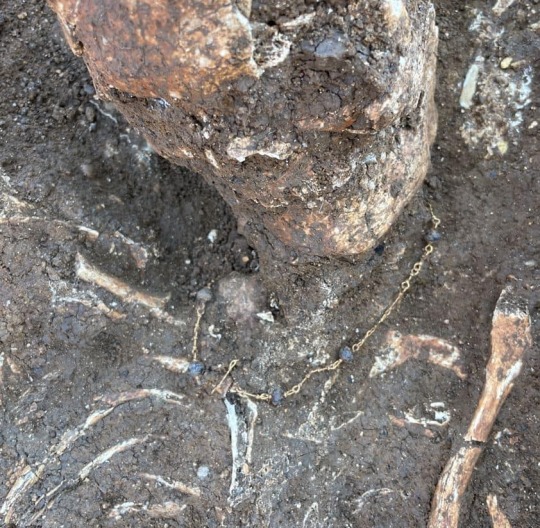
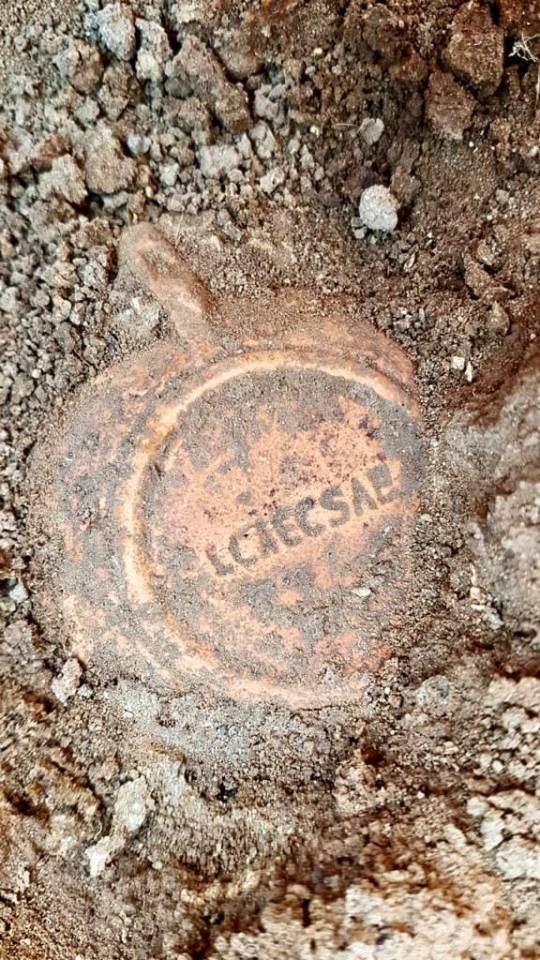


#Ancient Roman Elite Necropolis Discovered in Italy#ancient city of Tarquinia#ancient graves#ancient tombs#funeral goods#gold#silver#ancient artifacts#archeology#archeolgst#history#history news#ancient history#ancient culture#ancient civilizations#roman history#roman empire#roman art
72 notes
·
View notes
Text
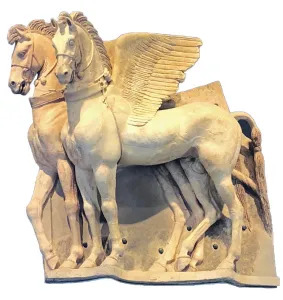
The terracotta statue of winged horses discovered in 1938 in Tarquinia, one of the leading cities in ancient Etruria. The horses were in fragments and it took decades to reconstruct the whole statue.
#ancient rome#Etruscans#etruria#ancient italy#ancient#ancient civilizations#ancient art#ancient artefact#it must have taken a lot of dedication to assemble it bakc together
71 notes
·
View notes
Text
First round of polls!
What kingdom would Tarquinia (Tanaquil) and Volsinii (Sethre) be in?
* i am not adding all of the city states because I am not going to for the other ancients (mainly due to lack of research which I do wanna do and hopefully this event might bring some motivation?) so it would be honestly unfair but not adding Tanaquil feels very wrong due to her prominent role in Etruria
> we are talking about one of the oldest cities in Etruria, and in mythology it was a story of two heroes
Thyrrenius who gave his name to the Etruscans ("Thyrrenoi") and Tarchon who gave his name to Tarquinia (Tarchna)
Idk if I am explaining myself?? But I hope you can understand why it feels personally wrong not to include her.
Plus she has a ruler role in Canon verse too so she would be the king while Sethre is the jack
#hws etruria#aph etruria#//mun🌻#aph ancients#hetalia#hetalia ask blog#hetalia oc#Cardverse au#//I hope I can show her soon but I have not been doing a lot of non-ask related art#//The whole deal with Thyrrenius and Tarchon is so interesting because it also mention Aeneas (??)#//which I mean does not exactly deny its etruscan origin! Because Aeneas was a Greek hero and they were Greek copy-#-lovers yeah lovers they liked Greek mythology a lot! (I do kid when I say copycats I do not think they were e xD it's just a tease)#// all things considered i want to know more about Etruscan myth because it's very interesting :3#//tho the only thing that makes me doubt it's etruscaness is just they did not call themselves Thyrrenoi xD#//yeah I think this is the first time I reveal Sethre is Volsinii here
4 notes
·
View notes
Text
My Hetalia Fic Lore Masterpost #1: Etruria
Hello everyone! I've decided that I'm writing too much ancient Hetalia fanfic for my own good, and have decided to create a series of posts explaining various OCs and/or events so that you guys don't have to read like 6 different things to understand what the heck is going on.
We'll start with one of my favorite OCs, Etruria, who's a minor deal in Brutus and Achilles and a massive deal in The Tyrrheniad :)
Etruria (~900 BC-351 BC) whose human name was Mamarce, was a personification of the region of Etruria in central/northern Italy. Etruria was never unified, but rather a collection of city-states. Why didn't I make a bunch of OCs instead of just Mamarce? Mostly for the symbolism, but we'll get to that later.
Mamarce was fairly lonely growing up, with his only real companions being two wolves who he had tamed. He admired the Greek city states to his south, and desired to be admired by them back, but they thought he was a try-hard and made fun of him for being scrawny and barbaric.
Around 750 BC, his luck turned around when a bunch of humans brought him a child who was rumored to be immortal. This child ended up being his brother, Romulus (Rome!) who he loved dearly. Despite all the Greek states making fun of him, Mamarce had a bit of a golden age where he controlled the western Mediterranean and a vast amount of territory in Italy. This golden age began to end, however, when Rome overthrew its Etruscan monarchy in 509, and Etruria lost the Battle of Cumae in 474.
I'm not going to give many details because I want to avoid spoilers for people who haven't read my works, but Mamarce had three children, Tuscany (Thefarie/Tiberius/Tiberio Mamercio), Parma, and Modena. In 358, after growing tensions between him and Romulus, he went to war against Romulus, during which he was killed. He was buried in a tomb in the necropolis of Tarquinia, and his children were adopted by Romulus.
Interestingly (and extremely relevant in Brutus and Achilles) Mamarce's death became the origin of Romulus and Remus myth at some point after his death.
Mamarce is featured in the following works:
The Tyrrheniad--This is the major fic involving Mamarce. It documents his relationship to Romulus throughout the centuries, starting with Romulus' discovery and ending with Mamarce's death.
Brutus and Achilles--This is actually the first fic that Mamarce appeared in! It takes place in 1859 AD, so a long, long time after Mamarce died, but frequent reference is made to his death, and his body appears in the chapter "Frater Meus." The main plot, however, concerns Lovino and Herakles trying to kill Feliciano, Sadik, and the Kingdom of Sardinia.
Hetalia Poetry Collection, "The Burial of Mamarce"--One of the poems in my Hetalia Poetry Collection. Describes Mamarce's burial.
#hetalia#hetalia ocs#historical hetalia#aph ancients#the tyrrheniad#monaluisa fic masterpost#aph etruria
3 notes
·
View notes
Text
The Best Day Trips from Civitavecchia Port: Unforgettable Adventures a Short Distance Away with RomeCabs
Discover Unforgettable Day Trips from Civitavecchia Port with RomeCabs
Welcome to Civitavecchia Port, your gateway to unforgettable day trips and extraordinary adventures. Nestled along the picturesque Italian coastline, Civitavecchia is the perfect starting point for cruisers eager to explore the captivating treasures that lie just a short distance away. Today, we invite you to embark on the best day trips from Civitavecchia Port with RomeCabs.
Our private tours from Rome’s seaport include deluxe vehicles, complete with pickup and drop-off directly by the ship inside the port, ensuring a seamless and luxurious experience throughout your journey.
The Eternal City's Timeless Splendor: Rome Tours from Civitavecchia
No shore excursion from Civitavecchia is complete without exploring the eternal city of Rome. Immerse yourself in ancient history as you admire the Colosseum, walk in the footsteps of emperors at the Pantheon, and marvel at the grandeur of St. Peter’s Basilica. Toss a coin into the Trevi Fountain, and soak up the lively atmosphere of Rome’s bustling streets and charming piazzas like Piazza Navona, Piazza della Rotonda, and the Spanish Steps. Indulge in the mouthwatering flavors of Italian cuisine and refreshing creamy gelato.
Exploring Rome’s Hidden Gems
With our Rome tours from Civitavecchia, you’ll have the opportunity to experience iconic landmarks and explore Rome’s hidden gems at your own pace, ensuring an unforgettable journey through this vibrant city.
Enchanting Medieval Towns: Bracciano and Tuscania
There’s more to see from Civitavecchia than just Rome. For a glimpse into Italy’s medieval past, venture to the captivating towns of Bracciano and Tuscania.
Bracciano
Resting on the shores of Lake Bracciano, this town exudes timeless charm with its medieval architecture and picturesque surroundings. The highlight is undoubtedly the magnificent Castello Orsini-Odescalchi, a 15th-century fortress that stands as one of the best-preserved Renaissance castles in Italy. Explore its grand halls, elegant rooms, and panoramic terraces, and be transported back in time. Wander through Bracciano’s historic center, a delightful maze of narrow alleys, cobblestone streets, and charming squares.
Tuscania
Located in the Lazio region, Tuscania is another enchanting medieval town rich in history. The Church of San Pietro, with its intricate carvings and beautiful frescoes, and the Church of Santa Maria Maggiore, showcasing Romanesque and Gothic styles, are architectural gems. Stroll through Tuscania’s narrow streets and enjoy the local shops, cafes, and trattorias.
Historical Wonders: Ostia Antica and Etruscan Necropolis Cerveteri
For history enthusiasts, a day trip to Ostia Antica and Cerveteri from Civitavecchia offers a captivating journey through ancient Roman and Etruscan civilizations.
Ostia Antica
Just a short distance from Rome, the ancient city of Ostia Antica stands as a testament to the grandeur of the Roman Empire. Wander through the vast archaeological site, and explore well-preserved structures like the amphitheater, which hosted gladiatorial contests and theatrical performances. Discover the daily lives of its inhabitants through the remains of stunning mosaics and frescoes.
Etruscan Necropolis in Cerveteri
Cerveteri’s Banditaccia Etruscan Necropolis, a UNESCO World Heritage Site, is a vast burial site that showcases the mysterious Etruscan civilization. The Tomb of the Reliefs, with its intricate carvings, is a highlight. Explore the distinct architectural styles and burial practices of the Etruscans and gain insight into their customs, beliefs, and artistic achievements.
Ancient Splendors: Tarquinia’s Etruscan Treasures
Tarquinia is renowned for its Etruscan heritage and boasts a wealth of archaeological treasures and a charming medieval historical center.
Monterozzi Necropolis
The Monterozzi Necropolis in Tarquinia, recognized as a UNESCO World Heritage Site, features impressive burial chambers like the Tomb of the Leopards, adorned with stunning frescoes. Visit the Etruscan Museum to see an extensive collection of artifacts that provide a deeper understanding of Etruscan culture.
Tarquinia’s Medieval Historical Center
Wander through Tarquinia’s historical center, with its narrow, winding streets and well-preserved medieval architecture. The Palazzo Vitelleschi, housing the National Museum of Tarquinia, showcases remarkable medieval and Renaissance art. Don’t miss the town’s imposing medieval towers, offering breathtaking panoramic views of the surrounding landscape.
With RomeCabs, your adventures from Civitavecchia Port promise to be seamless, luxurious, and unforgettable. From the eternal city of Rome to the enchanting medieval towns and ancient ruins, let us take you on a journey through Italy’s rich history and captivating beauty.
Grazie e buon viaggio from RomeCabs :)
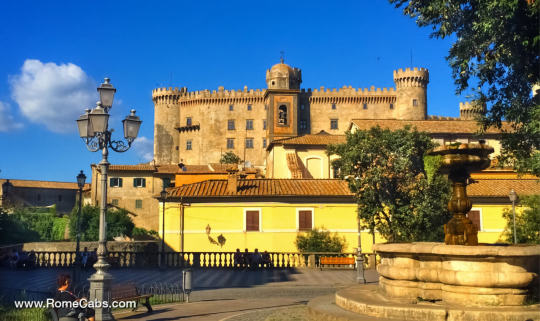
#romecabs#rome cabs#rome#italy#rome tours#romecabs tours#romecabs tour#Civitavecchia Shore Excursions#Shore Excursions from Civitavecchia#Rome Cruise Tours#Rome cruise port tours#Tours from Civitavecchia to Rome#Best Shore Excursions from Civitavecchia
0 notes
Text


Archaeologists were baffled, to say the least, when they discovered an ancient Roman necropolis containing 67 dressed skeletons buried in 57 ornate tombs. Unearthing ancient Roman tombs is not remarkable, but this particular find is extraordinary.
Workers have been digging near Rome, Italy, preparing to install a solar power plant for the past two years. Experts were called to the site when ancient bones and artifacts started to turn up on a 52-acre patch of land close to the ancient city of Tarquinia.
The shallow tombs were found just 20 inches below the surface. They were almost popping out of the grass, but nobody had ever noticed them before.
Curiously, the unearthed ancient skeletons buried in the tombs were still dressed.
“We found several skeletons still wearing their expensive stockings and shoes,” Emanuele Giannini, lead excavation archaeologist at the site, told CNN. “All these riches, and the fact that the bones show no sign of stress or physical labor, (leads us to believe) these weren’t local farmers, but upper-crust members of Roman families coming from cities.”
1 note
·
View note
Photo
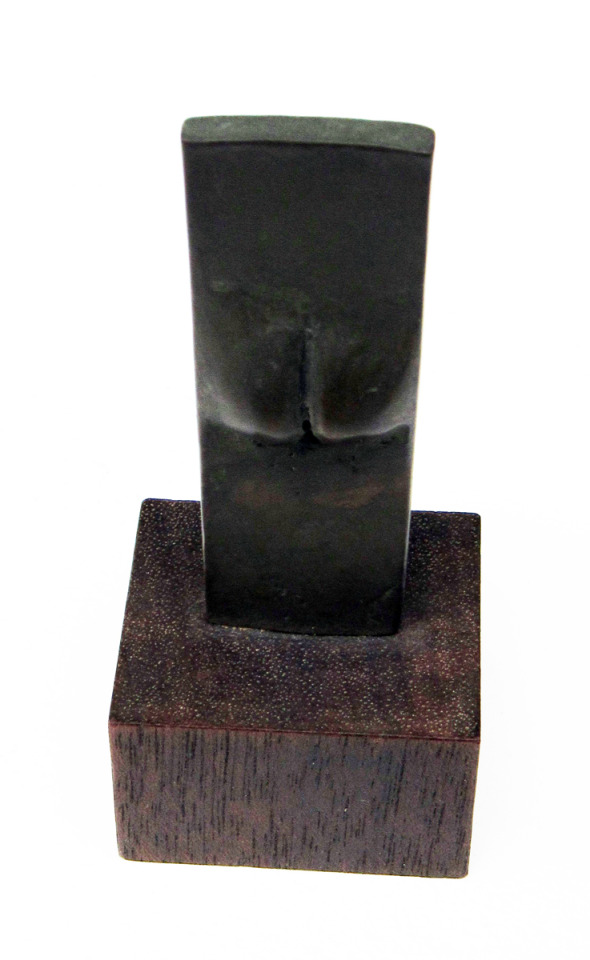


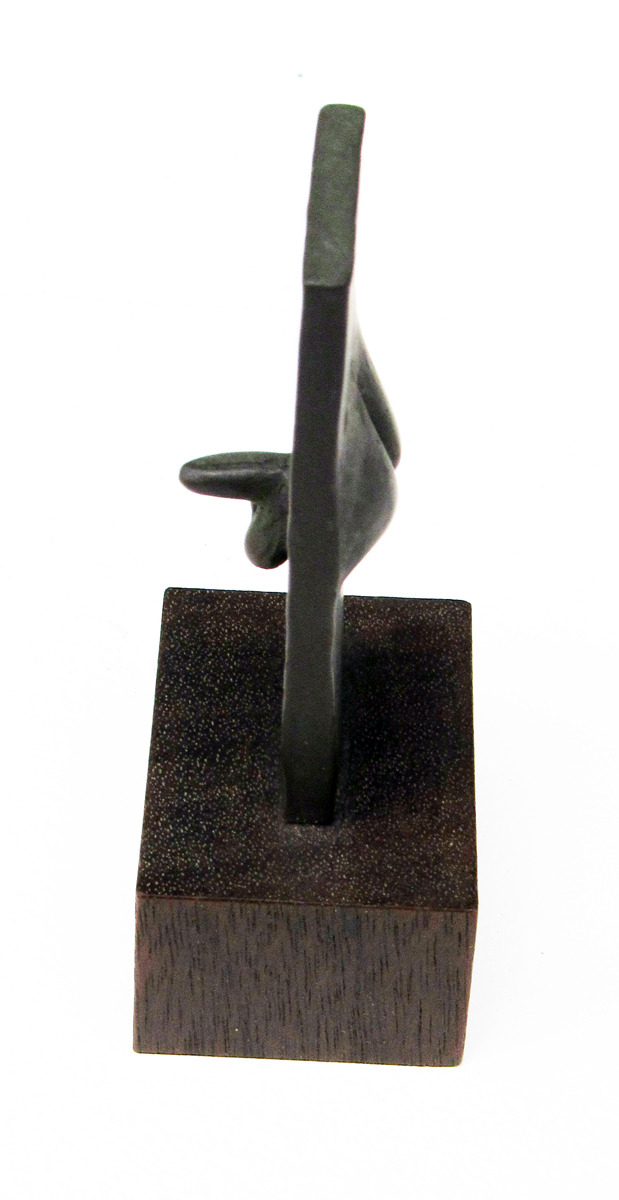
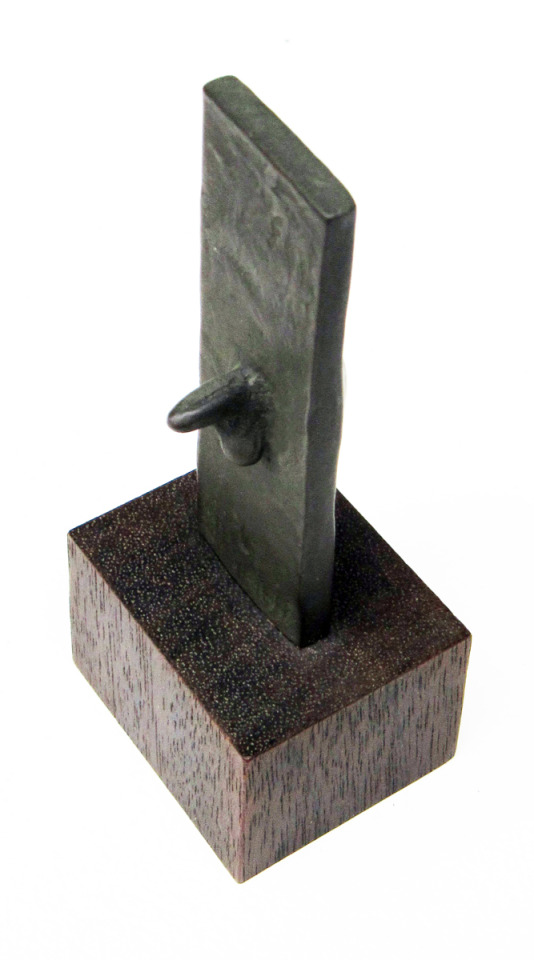
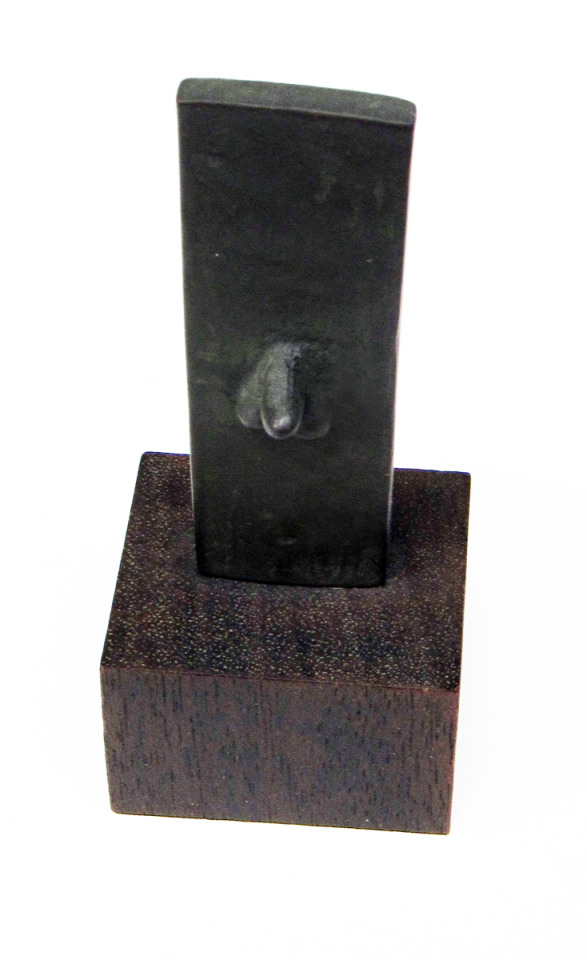
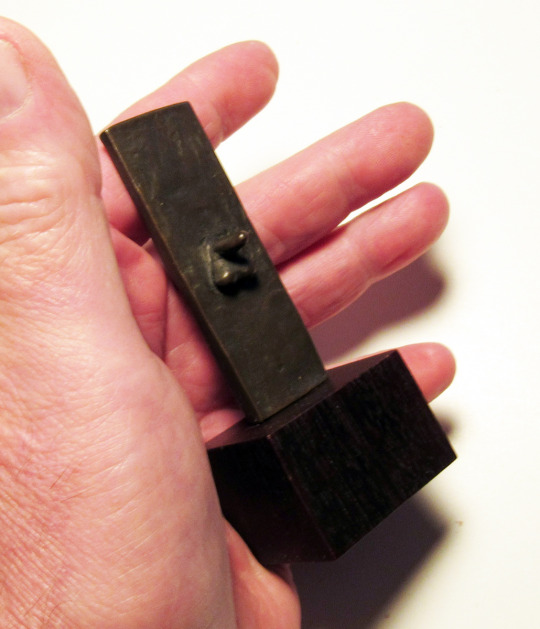
FLATGUY (my copy of an Etruscan votive figure) - cast bronze on mahogany base - 3⅞"x 1¼"x 1⅝" - 1993
This piece and a companion female votive figure were copies done from memory after having seen several examples of these stylized flat pieces displayed in the Archeological Museum of Perugia.
Perugia is the name of the modern Italian city which was Perusna in Etruscan times (circa 900 BCE to 311 BCE). Having visited and looked at Etruscan artifacts in archeological museums in many other Italian cities — Rome, Florence, Orvieto, Chuisi, Cortona, Tarquinia, Arezzo, Bologna — I have seen numerous examples of similar small bronze votive nude figurines, however none except those displayed in Perugia manifest this distinctively stylized rectangular body form. It suggests to me that an ancient Perusna artisan came up with this quirky innovation and all the examples in the museum came out of their workshop. Judging by their artifacts, the Etruscans had quite a sense of humor.
#art by others#other's artwork#art by me#my artwork#Etruscan#antiquity#ancient#copy#bronze#sculpture#male figure#rectangle
96 notes
·
View notes
Text
Trip Review: Tarquinia and Tuscania
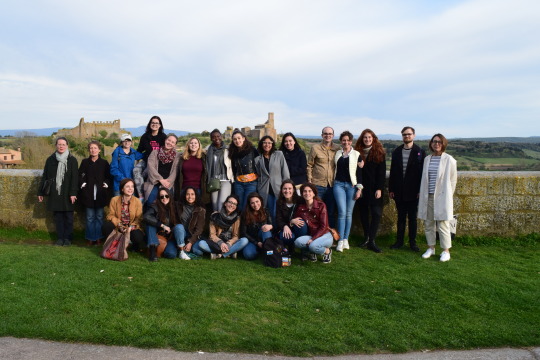
On Saturday, April 6th, the Art History Society organized a trip that took us back in time, yet not that far away from Rome, to Tarquinia and Tuscania.
Most visitors to Rome believe they are visiting the ancient heart of culture on the Italian peninsula. Few realize that the Romans were preceded by an earlier civilization of Etruscans who flourished in pre-Roman Italy. The Etruscans broadened their influence in the Ancient world because they traded goods across the Mediterranean. The elite, richened by the flow of material wealth and cultural influences, developed distinctive traditions and iconography to express their identity. The monuments most visited in Central Rome are largely imperial or religious monuments, grand marble testament to the glory of the Roman and Catholic empires. The Etruscan art in Tarquinia, however, is the art of lived culture, of families, of fishing, hunting, and banqueting, of celebration and mourning.
First, we visited the Etruscan Necropolis of Tarquinia. The word necropolis means “a city (polis) of the dead (necro).” The Etruscan Necropolis in Tarquinia is not a cemetery as one knows a cemetery today, but a network of underground house-like structures that ancient Etruscans regularly visited to spend time with their deceased relatives. In the Necropolis, there are over 200 tombs with wall paintings dating as far as 7th century B.C, that show elite banquets, gardens, games, sports, dancers, demons, and spirits. For instance, we were astonished by the Tomba della Caccia e Pesca (the Tomb of Hunting and Fishing), where the first room was lavishly decorated with several kinds of plants, bushes, and trees, giving a sense of being back above the ground level, around the green hills and woods of Tarquinia. In the next room, the walls were painted in a seascape, which reminded us of a sea we saw before entering the tomb. The wall painting showed a sea full of swimming and jumping fish, that are being caught by men on a boat, and a sky full of flying birds in different colors. There was even a rocky coast with a man jumping off a cliff into the blue water of the sea. Among many, we especially admired Tomba dei Giocolieri (the Tomb of Jugglers), as well as the most famous two, Tomba degli Àuguri (the Tomb of the Augurs) and Tomba dei Leopardi (the Tomb of the Leopards). We could look at the same wall paintings that Etruscans looked at 2500 years before us.
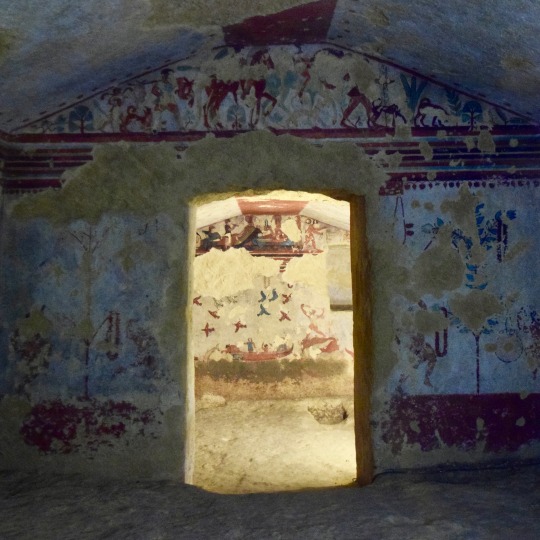
The National Museum of Tarquinia (Museo Archeologico Nazionale Di Tarquinia) houses most of the best preserved and most beautiful of the objects found in the Necropolis. The museum is located in Renaissance Palazzo Vitelleschi, built in 1436 by Cardinal Giovanni Vitelleschi, overlooking a little piazza. In the museum, we encountered Etruscan sarcophagi that were originally placed in many of the tombs. The sarcophagi were extraordinary ornamented, for instance with flora and fauna reliefs, as well as richly painted. Moreover, their lids were made to resemble statues of the deceased. The deceased were depicted as sleeping, reclining, eating fruit, and smiling at the viewer. We even found one sarcophagus that depicted a man who perkily braced his head on his folded arm, with his gaze stuck at us. As the Etruscans were trading with other Mediterranean civilizations, we saw not only the examples of Bucchero, a ceramic type specific to Etruscans, but also artifacts from ancient Greece and Egypt.
Once one ventures to Tarquinia, it would be a shame not to visit nearby Tuscania, which has one of Italy’s most fascinating churches. The church of San Pietro overlooks the hilly landscape of the province of Viterbo. San Pietro is a combination of a Gothic and Romanesque style, surrounded by towers, ruins, and grass. In fact, with help from Professor Hansen, we managed to find Roman ruins from ca. 2nd century A.D. We could hardly take our eyes away from the façade of San Pietro, that was filled with complex symbolism and iconography, ranging from exotic animals to Christian saints. The contrast of the white marbles with the brown bricks and green grass made it seemed unreal, almost as from a movie set.The breathtaking rose window seemed to be made out of lace rather than a stone. The interior, filled with cold air, was as impressive as the outside. The floor was decorated with geometric mosaics, while the columns set along the aisle were a fabulous mixture of styles. Each capitol was different, with some of them being ancient, some made for the church itself. Next, we left for the center of Tuscania. We climbed the narrow streets to reach the elevated park and to marvel at the panoramic view of the green hills, impressive city walls, and breathtaking architecture.
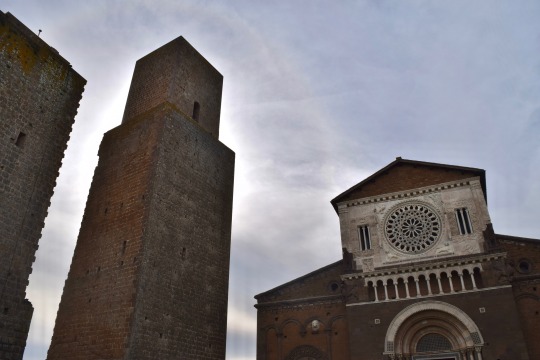
The Art History Society organizes at least one trip each semester to visit some of the less well-known, but absolutely amazing art sites just outside of Rome. Many places are still on our list, and we will keep you posted.
~ AHS Social Media Coordinator Natalia Stanusch
#art#arthistory#jcuarthistorysociety#@johncabotuniversity#johncabotuniversity#jcu#WhenRomeIsYourCampus#trip#student#student-run#architecture#ancient#antique#Etruscan#EtruscanArt#Tarquinia#Tuscania#church#medival#gothic#romanesque#sightseeing#photography#italy#italia#review#tripReview
1 note
·
View note
Text
From Civitavecchia: Tarquinia & UNESCO Site Visit with Lunch GetYourGuide
From Civitavecchia: Tarquinia & UNESCO Site Visit with Lunch GetYourGuide
Discover the Etruscans on this guided cultural tour and visit the city of Tarquinia with its UNESCO world heritage site. Explore the ancient Etruscan necropolis with tombs painted more than 3000 years ago, before enjoying a typical Italian lunch.
View On WordPress
0 notes
Photo
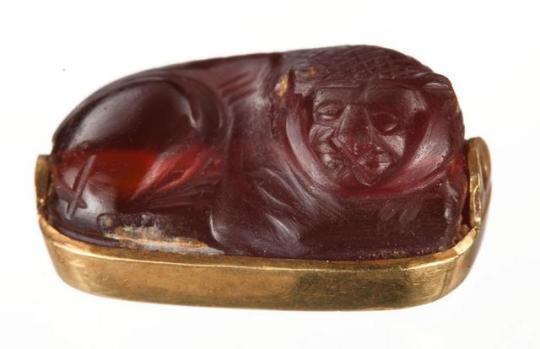


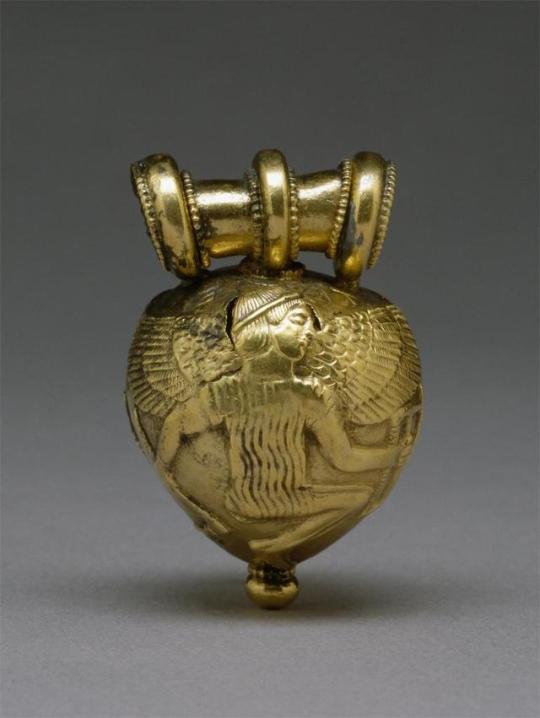
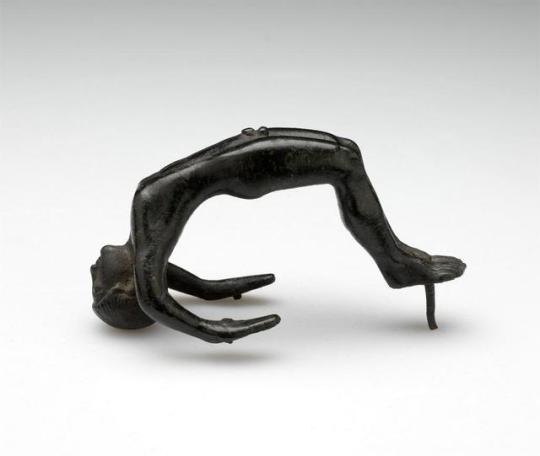
First Etruscan Settlement Found in Sardinia
By Jean Marie Carey
An Etruscan settlement dating back to the Ninth Century BCE has been found on the Sardinian coasts near Olbia. Archaeologists working in the Sassari and Nuoro provinces found the ruins on the island of Tavolara. Etruria's famous cities including Populonia, Vetulonia, Vulci and Tarquinia flourished during the Iron Age. The Monte Prama statues in Sardinia date to this era, as well so-far-discovered intricate gold jewelry and elaborate funerary statuary.
Bronze mirrors, found at this and at hundreds of Etruscan burial sites, are beautifully detailed examples of this ancient work. Most are cast in the shape of a disk with a handle. The back of the mirror was engraved or worked in relief, usually with mythological subjects from Greek art, or it was covered with inscriptions. The other side, was highly polished to provide a reflection. Shown here is a mirror handle is in the form of a serpent or a bird. The back is incised with four figures, one with a headdress. The scene may illustrate the judgement of Paris, an apt subject for a mirror.
According to a bulletin published 8 January in the Italian edition of ANSAMed, the full results of the excavation will be released later in 2018.
References: “Etruscan settlement found in Sardinia for first time; sheds light on relations between Tyrrhenian Sea shores”, 8 January 2018. ANSAMed.it; and Xavier F. Salomon. “The Etruscan Experience” in Apollo. July-August, 2017, Vol. 186 Issue 655, p64, 6 p.; Apollo Magazine Ltd. Language: English, Database: Academic OneFile
Scarab of a Lion, Carnelian, mounted in a ring with band. C. 400 BCE. The John and Mable Ringling Museum of Art, Sarasota, Florida, Nr. SN1435.143.
Etruscan Mirror, bronze. C. 300 BCE. The Minneapolis Institute of Arts, Nr. 62.13.
Etruscan “leech” earrings, gold. C. 350 BCE. Rhode Island School of Design Museum, Providence.
Etruscan Bulla with Daedalus, gold pendant. C. 450 BCE. The Walters Art Museum, Baltimore, Maryland, Nr. 57.371.
Etruscan Acrobat (probably the handle of a cista lid), bronze. C. 350 BCE. Rhode Island School of Design, Providence, Nr. 85.107.1.
Further Reading: Colette Hemingway and Seán Hemingway. “Etruscan Art.” In Heilbrunn Timeline of Art History. New York: The Metropolitan Museum of Art, 2000–. (October 2004)
#art#archaeology#etruscan#etruscan art#sardinia#Tarquinia#italian art#italian#islan#peninsula#apollo magazine#jewelry#scarab#ancient world
376 notes
·
View notes
Photo




Tarquinia is an old city in the province of Viterbo, a region also called Tuscia, known for its outstanding and unique ancient Etruscan tombs in the widespread cemeteries which it overlies. The tombs expose magnificent and mysterious frescos, one of which, coming from the Tomb of hunting and fishing, is reproduced above. M. C. Escher visited Tarquinia in 1927. Around two decades later he started to draw his famous continuous patterns with animals and fishes, like the three reproduced here. I like to imagine Escher being inspired by the Etruscan reminisces from his youth for his own graphic style. The birds look alike, and fly in the opposite directions in both cases. Don’t you spot a connection?
13 notes
·
View notes
Text
The enduring influence of the Etruscans on Italian culture
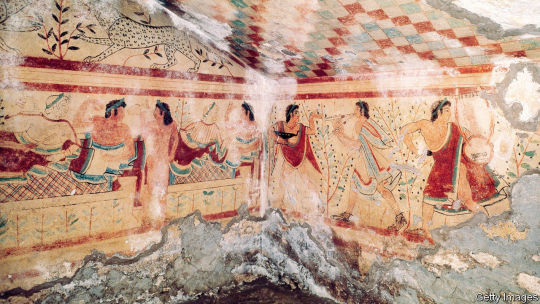
D.H. LAWRENCE was fascinated by the Etruscans. The English writer referred to the “lost” ways of the ancient Italian civilisation in his letters; in poems he imagined the people as “long-nosed, sensitive-footed, subtly-smiling”, yet “evasive and different”. In 1926 he had the idea to write a study of “Etruscan things”, travelling through Vulci, Cerveteri and Tarquinia. At the Monterozzi of Tarquinia he saw 6,000 tombs cut into the rock, 200 of which are painted, the oldest dating back to the seventh century BC. “It is as if the current of some strong different life swept through them, different from our shallow current today,” Lawrence wrote, “as if they drew their vitality from different depths that we are denied.”
Today, Etruscan necropolises are UNESCO World Heritage sites and in the summer months, when tourists flock to Tuscany and the surrounding regions, many visitors will be awed by the vibrant frescoes as Lawrence once was. The only pre-Roman urban civilisation on the Italian peninsula, Etruscan city-states in Tuscany, western Umbria and Lazio flourished as centres of culture and commerce from approximately the tenth to the first century BC, when they were defeated and assimilated into the Roman Republic.
Get our daily newsletter
Upgrade your inbox and get our Daily Dispatch and Editor's Picks.
It is Roman writers, such as Livy and Pliny the Elder, who produced the official histories of the Etruscan era. They observed that the Etruscans were well-organised politically, skilled in engineering and almost proto-feminist (their mixed-gender banquets shocked their contemporaries, the ancient Greeks). But as few Etruscan texts have survived, and their language is only partly decoded, much about the ancient way of life remains mysterious. It is the vast cities of the dead, with tombs packed with treasures for the afterlife, which are the richest source of clues.
Yet for all this opacity—or perhaps because of it—the Etruscans exert a deep and continuing influence on Italian culture, particularly art. In the Arena Chapel in Padua, Giotto’s depictions of Satan bear a resemblance to Charun, an Etruscan demon present in tomb paintings at Tarquinia; Massimo Campigli’s female nudes also evoke the stylised figures of those historic works. In the 20th century Arturo Martini sculpted his own hybrid fire-breathing monster inspired by the Chimera of Arezzo, a famous and intricate piece of Etruscan bronze-casting. In 1976 Michelangelo Pistoletto, a member of the Arte Povera group, produced an installation which reflected a copy of “The Orator of Trasimeno”, an Etruscan statue, in a mirror to create a dialogue of sorts between past and present.
The Etruscans occupy a place in the popular imagination, too. The design for the football used at the World Cup of 1990 (held in Italy) took in an ancient motif of lions’ heads. Silvio Berlusconi constructed an enormous mausoleum at his home in Arcore, near Milan, in 1994: the imitation hypogeum, fit for an Etruscan prince, includes carved niches and objects a media tycoon may wish to take into the next life. (The edifice violates local building regulations and has been declared illegal.) The Etruscans have inspired comic books, too. Disney published “Topolino L’Etrusco” (“Mickey Mouse The Etruscan”) in 2011 as part of its World History series.
From August 22nd-25th, Tarquinia hosts the “DiVino Etrusco” festival (a pun on “divine Etruscan” and “Etruscan wine”), a celebration of the region, which attracted 15,000 visitors in 2018. Restaurants in Tuscany and Lazio are often marketed as ristorante etrusco, but the word is adopted as a marker of identity, too. Older residents may bear the nickname “l’Etrusco”; people are sometimes said to have inherited “Etruscan” facial features, particularly long noses and high cheekbones. An Etruscan identity appeals because it suggests atavistic lineages and a regional allegiance.
Indeed, in the past some Italians have considered Etruscan artefacts to be a birthright of sorts. To the dismay of the state, tombaroli, or tomb robbers, have often beaten archaeologists to sites of importance, with a large number of artefacts ending up on the black market. Post-war economic inequality left sections of Italian society cash-poor and as it was common for farmers and constructors to unearth Etruscan tombs and their treasures, it was not unusual for these artefacts to be used as currency, with doctors and lawyers reputedly being offered pots as payment for professional services. In 2004 a legislative decree was passed obliging a certificate of authenticity and provenance to be provided in the sale of artefacts, a move which seems to have led to a decrease in illegal trafficking.
The air of mystery that surrounds the Etruscans, which so captivated Lawrence, endures to this day. Etruscology remains a popular academic discipline in Italy. The National Etruscan Museum of Villa Giulia, Rome, is thriving: in 2018 the museum received 82,300 visitors, a 14.3% increase on the previous year. In a country where ties to family and place are deeply rooted, it is unsurprising that today’s inhabitants of central Italy retain a strong attachment to their ancient ancestors.
https://ift.tt/2TKQEd4
0 notes
Text
6 - June 26, 2018
June 26, 2018
Today, we visited the city of Tarquinia and the nearby ancient Etruscan tombs and looked out to where an ancient Etruscan city used to be, ‘Estruria/Tuscia’. “This was one of the most important Etruscan towns” -tour guide Pina. Pina told us about how there were 3 different periods of how the Etruscans were going to the other life. The Villanovian tombs were from the 9th century B.C. and the people were all cremated and put in urns. The tombs were under ground in the 5/6th century B.C. and the phase was incineration (2nd page of the 3 page story of the different periods of how the Etruscans were put to rest). In the 3rd century B.C, there were family tombs with coffins made of stone, incineration (cremation) and just putting the bodies in sarcophagi.
The Tyranean sea is the sea of the Mediterranean that Tarquinia is right next to. In some of the tombs, the people who rediscovered them thought some of the figures in them were lions, however they were spiritual guardians not Lions. Some of the frescos found are really interesting because the bodies are in movement in the fresco in the Tomba della leonesse instead is just standing in once spot. A lot of the frescos also pay homage to the god of wine. There are also almost always instruments included in the frescos.
The Etruscans has the first flexible shoes in the history of man and they can be seen in many of the frescos as well and also pairs were found inside the tombs. Lotus flowers, pomegranates, waves and dolphins, birds flying at the back, and banquet/feast on sides were also images seen in the frescos of the tombs we visited. In 474 B.C. the naval battle of Cumae took place between Cumae and Syracuse against the Etruscans.
We then visited the Tarquinia National Museum which used to be a summer home Palace in Tarquinia where Pina showed us around the museum where we views many Etruscan artifacts. One artifact included the black pottery called ‘bucchero’ which used to be very finely made and once they got more popular began being less finely made, as shown to us by Pina. There were a lot of Greek and Egyptian influence in many of the Etruscan artifacts. Tarquinia was a pleasure to visit.
0 notes
Text
Week 10
I really enjoyed this week’s reading and learning about the Etruscans. Prior to this week’s reading, I had never even heard of the Etruscans, so it was all new and very interesting information to me!
It helped to learn that the Etruscans homeland, Etruria occupied the west-central part of the Italian peninsula and is now modern Tuscany. I knew where Tuscany was geographically, so it helped me to better understand this chapter. I then learned that the Etruscans never formed a single nation, but coexisted as separate-city states with their own rules and laws. Additionally, the Etruscan fleet controlled the western Mediterranean, and was an important trading nation.
It was very interesting to learn the ways in which Greece and Rome influence Etruria and in turn how Etruria influenced Greece, Rome, and other areas. For example, the Etruscans were largely responsible for extending Greek influence to northern Italy and Spain. I also found it interesting to learn that Etruscan language was written from right to left. Additionally, it was also another interesting and mysterious point to learn that Etruscan literature, which according to Roman sources was rich and extensive, has disappeared. Yet, we are still able to learn about the Etruscans due to their buried tombs and necropoleis (cities of the dead), for the Romans left them undisturbed, and therefore they are major sources of information about the Etruscans.
Next, was Etruscan architecture. Greece was stated as being an inspiration for large-scale architecture in Etruria. Remains from temple foundation indicate that the architectural plans were based on Greek prototypes. Yet, late Etruscan temples remained distinct in some ways, for they had gabled porches but not pediments. I then learned that the Etruscans used wattle-and-daub construction for the superstructure by reinforcing the branches, also known as the wattle, with clay and mud, also known as daub. Stone was only used for the podiums.
Next, was Etruscan pottery and sculpture. The few surviving sculptures indicate a thriving industry in bronze and like the Greeks, the Etruscans cast bronze by the lost-wax method. My favorite piece of art from this chapter was the she-wolf, the so called Capitoline Wolf. The statue captures the aggressive anger of a mother protecting her cubs, and I was extremely impressed by the detail and their ability to convey such an accurate expression of aggression and protection by the wolf.
The book then discussed women in Etruria and how they were depicted in Etruscan art. The Etruscan’s differed significantly from the Greeks in their attitude toward women. Women participated more in public life with their husbands and held higher positions than women in ancient Greece. For example, wives participated in banquets with their husbands. Additionally, wealthy Etruscan women were unusually fashion-conscious and wore elaborate jewelry that corresponded with their rank. Additionally, bronze mirrors used by Etruscan women have been later found, and are decorated with mythological scenes. Lastly, artists often depicted myths in which women dominated men by being older, more powerful, or higher in divine status, again showing the significant difference in Etruscan’s attitude towards women.
Lastly, there was lots of information on funerary art, but we do not know exactly what the Etruscan’s specific view on the afterlife was. Often, they cremated their dead and buried ashes in individual tombs or urns, which often had a lid in the form of a human head. Some of the urns took the form of houses and therefore provided us with a glimpse of domestic architecture. There were also sarcophagi, which are like urns and hold cremated remains, except the sarcophagi figures represent a married couple. From both this and other evidence, we know that the family unit was an important element to their art and society. In later Etruscan history, an unusual limestone cinerary statue exists of a monumental female with a swaddled child lying across her lap. The downcast expression of the female is appropriate for this Etruscan funerary figure. Additionally, on both sides of the chair/throne is a sphinx, which testifies to the importance of this figure, and allows us to assume that this statue is probably of a goddess. The book states that she may perhaps be the goddess of a protector of mothers who died in childbirth. Lastly, hundreds of tomb paintings have been discovered in underground tombs of Tarquinia, a site northwest of Rome. These paintings were usually frescos and often represented funeral rites or optimistic scenes, but still had elements that hinted at death.
5 notes
·
View notes
Text
From Ship to Rome: How RomeCabs Transforms Your Civitavecchia Shore Excursion in Italy
Buongiorno and welcome to the RomeCabs Travel blog!
Embark on an Unforgettable Civitavecchia Shore Excursion
At RomeCabs, we specialize in turning your Civitavecchia experience into a seamless adventure. With over 20 years of providing luxurious, private tours, we’re here to make your shore excursion extraordinary.
Convenient Pier Pick-Up and Drop-Off
Your journey begins the moment you step off your ship. RomeCabs has special licenses and security clearance to pick you up and drop you off directly inside the cruise port of Civitavecchia, right next to your ship. No long walks or shuttle buses – just step into one of our deluxe Mercedes vehicles, and let your adventure begin.
Private Tours for Ultimate Enjoyment
Say goodbye to crowded buses and hello to personalized experiences with RomeCabs. Our private tours from Civitavecchia offer privacy and maximum enjoyment. Whether you’re exploring Rome, the Roman Countryside, or indulging in a wine tour in Orvieto, our dedicated drivers focus solely on you and your companions.
Exciting Shore Excursions
Make the most of your time in Civitavecchia with our exciting shore excursions:
Rome Excursions: Explore ancient monuments, lively squares, and charming neighborhoods like Trastevere. Visit iconic sites like the Colosseum, Trevi Fountain, and St. Peter’s Basilica.
Countryside Tours: Escape to the medieval castle of Bracciano, the hamlet of Ceri, or the Etruscan necropolises in Tarquinia or Cerveteri. Immerse yourself in the medieval charm of Tuscania.
Wine Tour to Orvieto: Taste exquisite wines at an organic winery in Umbria and explore the ancient city of Orvieto with its stunning cathedral and artisan shops.
Deluxe Mercedes Vehicles
Relax in our deluxe Mercedes vehicles, prioritizing your comfort and safety. Our fleet is meticulously maintained, offering a first-class experience. Our vehicles have professional limo licenses, granting exclusive access inside the cruise port and within Rome’s historical center.
Expert English-Speaking Drivers
Our English-speaking drivers are specially licensed, ensuring your safety and providing insightful commentary. With years of experience, they expertly plan and execute your tours, taking you as close as possible to iconic attractions, minimizing walking distances, and maximizing sightseeing opportunities.
Book Your Tour with RomeCabs
With over two decades of experience, RomeCabs is your trusted partner for unforgettable Italian adventures. Book your tour with us today and let the adventure begin!

#romecabs#rome cabs#rome#exploreitaly#romecabs tours#travel#romecabs tour#italy#travelinspiration#rome tours#Civitavecchia shore excursionis#Shore Excursions from Civitavecchia#Rome excursions from Civitavecchia#Rome Cab#RomeCab#Tour Rome from cruise port
0 notes
Link
Civitavecchia is a pretty town, just across the Mignone River from Rome.
Known as Rome’s ancient port, it’s history goes all the way back to Etruscan times. If you’re seeking a tranquil holiday in Rome without all of its hustle and bustle, this place is your best bet. You’ll be amazed by the cleanliness in this little township, as well as the variety of open cafes and shopping spots!
As always when visiting a new place, you’ll want a list of the best things to do and visit while you’re here. Read on, and you’ll discover some pretty fancy, one-of-a-kind nooks you can visit while you’re in Civitavecchia, Italy!
1. Fontana del Vanvitelli
The Fontana del Vanvitelli is an enchanting fountain that is well preserved by the community and truly stands out, with its shades of white. It is made entirely out of travertine, a form of limestone. Located in close proximity to the harbor, Fontana del Vanvitelli was inserted into the walls as a means of defending the city against enemy attacks. The main detail of the fountain is its head, with its figure of a faun (half human and half goat).
2. Civitavecchia Port
This deepwater port of Italy was founded more than a millennium ago, under the watchful eyes of the Roman Emperor, Trajan. Today, it is home to a myriad of cruises, with many ferry lines operating from its base in Sicily, Sardinia and other parts of the Mediterranean.
There are shuttle buses (some complimentary, others with a fee) that will bring you to your ship or the Civitavecchia Railroad Station. It’s a great place to be if you want a few hours of salty air and later, a cruise trip to show you the sights of the ocean!
3. Aquafelix
Aquafelix is a water park that’s got waterslides for everyone to use, irrespective of your thrill level or age! Shows go on during the day, with tons of music being played all around. As far as meals go, you’ll be spoiled for choice with the menus at the pizzeria, bar and restaurant. There are huge solariums throughout Aquafelix and it’s also on the Top 10 list of the most beautiful water parks in the country.
4. Museo Archeologico Nazionale - Civitavecchia
It might seem tiny to some, but this national museum is power-packed. Each display has its own multi-language signage and, as far as moving about goes, the museum’s passages are wide and definitely intoxicating. It’s a well-lit, airy museum, that provides its visitors with interesting exhibits on Italy’s rich historical eras. There are two levels dedicated to pottery items, headstones and artifacts, too. And, the last we checked, there was no entry fee!
5. Terme Taurine
This is a bathing complex that dates back to the Roman times. It’s nestled atop a hill and is surprisingly not packed with tourists. The great thing about this place is that you’ll be able to walk around and touch the remains of the complex. There is also a decent amount of information available in English for international visitors. Entrance for non-guided entry is 5.94 USD.
6. Cattedrale Di San Francesco
This cathedral is the largest church in Civitavecchia and it is dedicated to St Francis of Assisi. It was constructed on the remains of what used to be a Franciscan church, that was erected in 1610. The church became a cathedral in 1805. It suffered some serious damage during bomb attacks back in 1943 and was finally restored under the guidance of Plinio Marconi, in 1950. The church has a singular nave with a baroque-themed double-ionic facade.
7. Santuario Madonnina delle Lacrime
This is a landmark that should truly be on your checklist, while you’re in Civitavecchia. The story goes that in February 1995, a small statue of the Virgin Mary was seen to be weeping blood, in a family garden in St. Augustine’s parish, Civitavecchia. It continued to weep blood into March that year for a total of 14 times.
Allegedly, the tears underwent scientific examination and were determined to be indeed made of human blood. In 1995, the Madonna was moved to the to St. Augustine’s Parish where it has been a site of pilgrimage, ever since. This is an intriguing display that mustn’t be missed!
8. Michelangelo Fortress
The Michaelangelo Fortress dominates the water, with its imposing design, said to be done by the famed artist, himself. While the interior is closed to the public, you will still be able to view the exterior architecture. Great for photos, there are open, public places along its foreshore. When you’re done, you’ll be able to rest at the cafes and restaurants that dot the place, all around.
9. Wine tours and tasting
A trip to Italy is incomplete without sampling the fruit of the grapevines. In Civitavecchia, there aren’t really any wineries, but all you have to do is head on to Montefiascone and Tarquinia, for some good sips of red and white wines.
Read also: Top 10 things to do in Antibes, France
From : https://wikitopx.com/travel/top-9-things-to-do-in-civitavecchia-italy-706385.html
0 notes